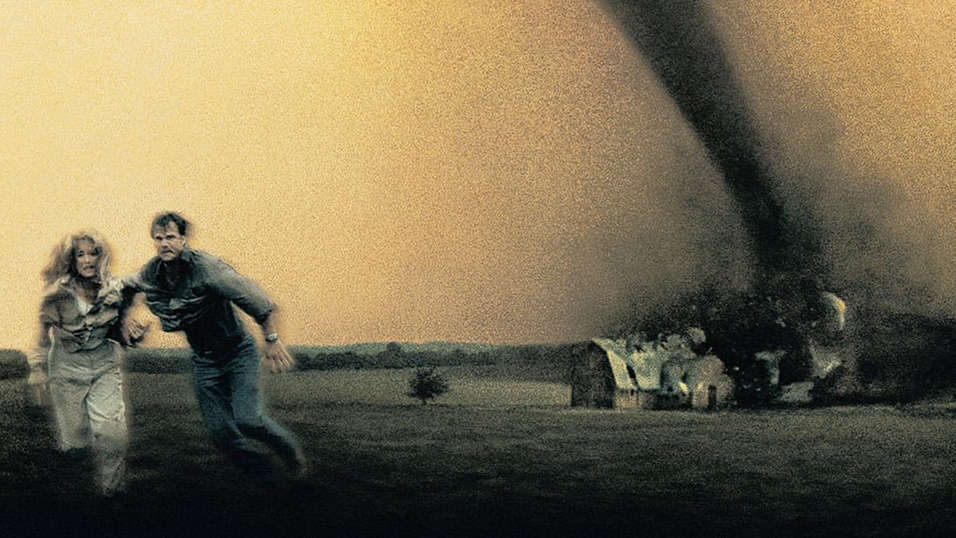Create a free profile to get unlimited access to exclusive videos, sweepstakes, and more!
Predicting tornadoes and flying cows: The science behind 'Twister'

Almost as soon as we started setting images to celluloid, we started making disaster films. James Williamson's Fire!, released in 1901, centers entirely on a burning house and the people who attempt to put it out. It probably speaks to something primal about us, that we like to see fictionalized destruction through the safety of a screen. One such disaster movie that's celebrating its 25th anniversary this week is Twister, the storm-chaser flick starring Helen Hunt and Bill Paxton.
Twister follows the pair as they try to study tornadoes and learn how to better predict when one is going to touch down. Along the way, they encounter rival researchers, deadly weather, and a flying cow. Is anything in Twister based on real science, or is the movie a bunch of Category 5 baloney?
STORM CHASING
Storm chasing certainly predates Twister, but it saw an uptick after the film's release. Professor John Knox of the University of Georgia looked at interest in meteorology over the years and identified what he calls the Twister Effect, an uptick in interest after the release of the movie. The number of meteorological majors increased by about 10 percent in the late '90s.
It makes sense. I've definitely harbored a quiet desire to see a tornado in person, ever since I watched the flick as a kid. Any time I've had occasion to travel through tornado alley, I've silently hoped to see one in the distance. To date, no luck.
Some people took that pursuit to heart, taking up storm chasing either for the adrenaline of it or for science. And, there's plenty of science to be had. The precise cause and mechanics of tornadoes still aren't well understood. While we know the conditions that may lead to tornadoes, weather patterns are chaotic enough that we can't figure exactly when or where one is due to touch down. It's possible, even likely, that we'll never get to a place where we can predict time and location of touchdown with anything nearing perfect accuracy — even more mundane weather forecasts are only accurate 80 to 90 percent of the time, and only over short timelines — but our predictions could get better. And when it comes to tornadoes, getting better could save lives.
PREDICTING STORMS
In 1948, a tornado struck Tinker Air Force Base in Oklahoma. The storm cut across the base, causing fatalities and destroying 117 aircraft with $10 million in damages. It was, at the time, the most destructive storm ever to hit Oklahoma. When the dust settled, the base's commanding general laid down a mandate: Such a storm should never hit the base again without a warning.
He tasked Robert C. Miller and Ernest J. Fawbush with investigating the storm and finding a way to predict them in the future. In the course of their investigation, poring over the data from the March 20 tornado and comparing it to previous storms, they found a number of similarities that they identified as potentially predictive. Just five days later, on March 25, Miller and Fawbush realized the day's weather had all of the same hallmarks. Even taking into account the statistical unlikelihood that a tornado would strike in the same place only five days apart, they decided to issue a warning.
As a result, air traffic was diverted, aircraft were stowed, and people were moved to more secure locations. Around 6 p.m. that evening, a tornado touched down almost exactly in the same place as the storm five days prior. It caused a further $6 million in damages and some injuries, but no one was killed. The loss of lives and property was limited because of the first-ever official tornado warning.
More information and a greater understanding of conditions allowed for a reduction of risk, and storm scientists have been improving on those methods ever since. In the late ‘70s, Dr. Alan Bedard and Carl Ramzy of the National Oceanic and Atmospheric Administration (NOAA) developed a new instrument for measuring the real-time conditions of tornadoes.
Bedard and Ramzy placed an anemometer (a device that measures wind speed), along with a thermometer, atmospheric pressure gauge, and a dew point sensor inside a 55-gallon metal drum with the intention of dropping the package within the path of an active tornado. They called their new tool the Totable Tornado Observatory, TOTO for short (and for obvious reasons).
TOTO was the direct inspiration for the Dorothy devices Hunt and Paxton's characters are trying to use to study tornadoes in Twister, though it wouldn't prove to be as successful as its fictional counterpart. TOTO attempted to fulfill its mission on a number of occasions over the next eight years. Scientists used a modified truck to carry the 400-pound barrel and deploy it where they thought a tornado might pass. However, the mission encountered a number of challenges, including the inherent danger of deployment, the unpredictability of tornadoes and their paths, and at least one design flaw.
TOTO's nearest brush with success involved a passing glance from a tornado but the package was top-heavy and tipped over. After TOTO was decommissioned, a number of other tools were devised, including "turtles," "dillocams" (named for their armadillo-like shape), and "snails." For reasons unknown, scientists apparently like naming tornado tech after animals.
Ultimately, these tactics gave way to technology such as Doppler Radar, which allows for the measurement of storms at a distance.
FLYING COWS
Now to address the question you surely all want answered: Can a tornado pick up a cow? The short answer is yes. The longer answer is an enthusiastic yes. This isn't even an anomaly — we're not talking about a one-off incident witnessed by an uncle's friend's brother.
There's documentation of tornadoes picking up livestock, and much heavier objects, dating back more than 100 years. These stories tell of cows, pigs, and horses picked up and, sometimes, set down without harm.
While claims of any particular instance of a cow (or a woman in a bathtub) may be difficult to validate, depending on the size of the storm, they are capable of lifting and carrying off objects much larger. Small, light objects are carried easiest and can sometimes land hundreds of miles away. In 1991, a personal check landed 223 miles from its origination point. But it isn't all that uncommon for large pieces of buildings, vehicles, and yes, even livestock to go for a ride on a tornado.
So, Twister's most iconic scene isn't a bunch of bulls***... even if that flying cow might reasonably have soiled itself out of fear.














